Vishnu is the protector of all that exists. His purpose is to return to Earth during times of turmoil in order to right the scales between good and evil.
Hindus believe he will be reborn one more time until the end of the world, making his total number of incarnations ten.
Vishnu's followers, who are known as Vaishnava, place him at the top of the pantheon. Vishnu is the sole deity for Vaishnavas. The worship of Vishnu alone is known as Vaishnavism.
Lord Vishnu's various avatars are often depicted in Vishnu Murti's - magnificent sculptures and idols carved from different materials like stone or brass.
Such artifacts usually stand at the center of worship in Vaishnava temples, representing Vishnu's divine power in symbolic form for devotees to show their devotion before.
This article would be delving into detail about the ten avatars of Lord Vishnu in all his glory.
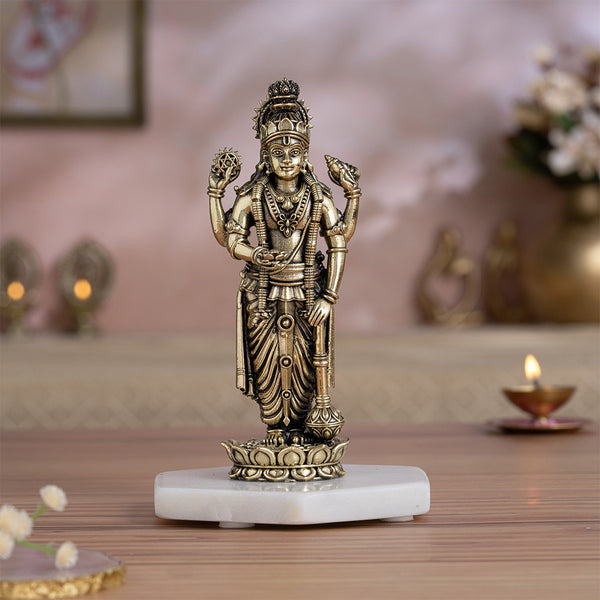
Brass Standing Lord Vishnu Murti (6 Inch)
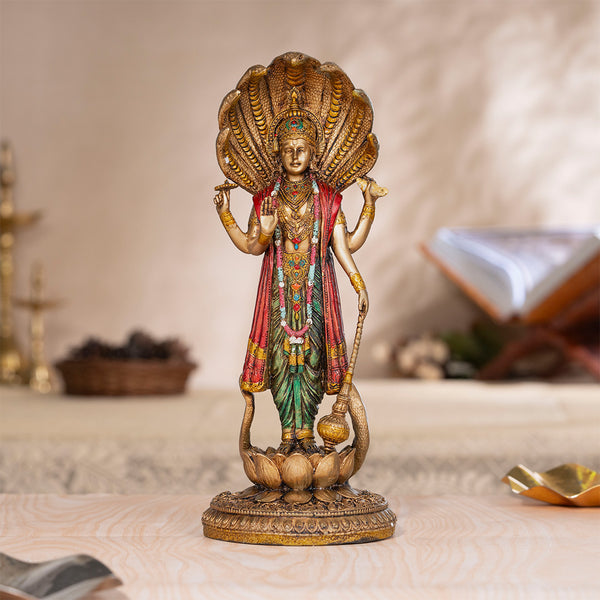
Lord Vishnu Standing Antique Idol (12 Inch)
The 10 Avatars of Lord Vishnu (Dashavatar & Yugas)
Hindus believe that when the earth is threatened by disorder or wickedness, Lord Vishnu would descend on it in one of his incarnations to restore justice.
The reincarnations of Lord Vishnu are commonly referred to as Avatars. According to Hindu mythology, Vishnu has taken on ten different guises or avatars.
The legend also states that the avatars began during the Satya Yuga, also called the Golden Era or Age of Truth, when gods ruled over humanity.
The ten incarnations of Vishnu worshipped by Hindus are known together as Dashavatara. Dasha means ten in Sanskrit, and Avatara means incarnation.
- - Satya yuga was the first era, and it was at this time that the first four avatars manifested.
- - Treta yuga was the second yuga, and it included the appearance of three more avatars.
- - Dawapara yuga, the third, saw the appearance of two new avatars.
- - The next yuga, Kali Yuga, in which the final Avatar of Lord Vishnu, Kalki, will come.
The end of this yuga is predicted to occur in about another 432,000 years.
A new yuga, appropriately named Kalki yuga, will begin after the evil and wicked forces on Earth are eradicated by the Kalki avatar, and the righteous are set free.
1. Matsya (Fish) Avatar

The fish-like avatar Matsya was Vishnu's first incarnation.
In the Matsya avatar, Lord Vishnu is said to have rescued the first man, Vaivasvata Manu, and the seven sages during the great Flood (huge cyclone), bringing a sample of every plant and animal species to the renewed earth on his boat.
Matsya can be pictured either as a gigantic fish or, more anthropomorphically, with a human torso joined to a fish's tail.
2. Kurma (Tortoise) Avatar

The word "Kurma" refers to a turtle; hence "Kurmavatara" literally translates to "incarnation of Lord Vishnu as a turtle." That was Lord Vishnu's second incarnation at that time.
During this incarnation, Lord Vishnu worked alongside gods and demons to extract nectar from the milky sea by churning it with his stick.
Lord Vishnu took additional precautions to prevent the devils from obtaining the nectar.
3. Varaha (Boar) Avatar

Varaha, the boar-like avatar, was Vishnu's third incarnation.
Lord Vishnu arrived as Varaha to rescue the earth (personified as the goddess Bhudevi) from the demon Hiranyaksha, who had taken her and hidden her in the primordial waters.
After killing the demon, Varaha lifted the Earth out of the water using his tusks, bringing Bhudevi back to her rightful place in the cosmos.
4. Narasimha (Half-man/half-lion) Avatar

The fourth incarnation of the Hindu god Vishnu, Narasimha, was a hybrid of humans and lions.
Hiranyakashipu, the rakshasa (devil), was awarded a great boon from Lord Brahma, making it impossible for him to be killed by man or animal, indoors or outdoors, during the day or night, on Earth or among the stars, with a weapon that was either alive or inanimate.
Lord Vishnu took on a human form but a lion's head and talons during his incarnation. The rakshasa was lying on his thighs at dusk on the threshold of his courtyard when he was disemboweled with his claws.
5. Vamana (Dwarf) Avatar

Lord Vishnu's fifth incarnation, or avatar, was a short man named Vamana. This is the first time an avatar has looked like a human and been seen with an umbrella made of wood.
Vamana Avatar Vishnu came down from heaven to restore Indra's rule over the heavens. Vamana went against the advice of his mentor Sukracharya and got three paces of land from King Mahabali.
Vamana then showed himself and grew to monstrous proportions, allowing him to walk effortlessly over all three dimensions.
With the first, he descended to Earth, and with the second, he descended to the Underworld. Due to his inability to keep his word, King Mahabali sacrificed his own head in order to appease the gods.
Vamana then put his foot down, granting the monarch eternal life in exchange for his modesty.
6. Parashurama (Warrior with an Axe) Avatar

Parashurama was Lord Vishnu's sixth incarnation. Parashuram, the son of Jamadagni and Renuka, was given an axe by Lord Shiva in exchange for his penance.
In Hinduism, he was the first Brahmin and Kshatriya (a warrior-saint) to share the responsibilities of both castes.
The father of Parashurama was able to feed King Kartavirya Arjuna and his army with the celestial cow Kamadhenu when the king and his army visited the saint in his ashram.
Jamadagni denied the king's request for the cow. The king infuriated, seized it, and subsequently leveled the ashram. The king was assassinated in his palace, and Parashurama single-handedly defeated his army.
The sons of Kartavirya took their revenge on Jamadagni and killed him.
Twenty-one times, Parashurama swore vengeance on every Kshatriya on the planet, and his blood filled five lakes. His grandfather, rishi Rucheeka, finally made an appearance and forced him to stop.
It is believed that Parashuram is still alive and performing penance on Mahendragiri mountain despite being an immortal Chiranjivi.
7. Rama (Prince/King of Ayodhya) Avatar
Rama was Vishnu's seventh incarnation. In Hinduism, the incarnation of Lord Rama is venerated as the archetypal brave male. The Ramayana, which tells his story, is a sacred text in Hinduism.
Ravana, the demon king of Sri Lanka, kidnapped Rama's wife, Sita, the daughter of King Janaka, when he was exiled from his own country for 14 years with his brother Lakshman and the God Hanuman.
After killing the demon king, he went to Ashoka Vatika (or vanam) in Lanka to rescue Sita.
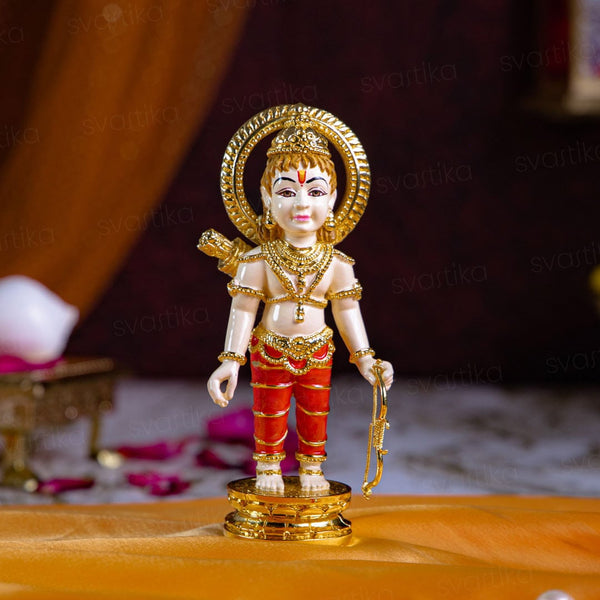
Childhood Form of Lord Ram - Gold Plated (6 Inch)
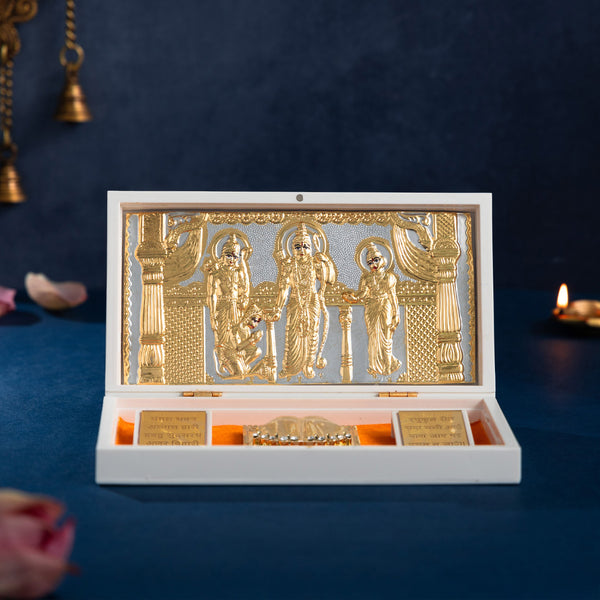
Svastika Ram Darbar Pocket Temple - Gold Plated
8. Balarama (Philosopher & Guide) Avatar

According to the Sri Vaishnava lists, Balarama was Lord Vishnu's eighth incarnation or avatar.
Balarama is also known as Baladeva, Balabhadra and Halayudha. He was Lord Krishna's older brother and is commonly recognized as an incarnation of Lord Vishnu.
Lord Vishnu took the form of this man. Moreover, he is sometimes thought to be the Sankarshana form of Vishnu as well as the eighth avatar that Vishnu has taken.
9. Krishna (Philosopher & Guide) Avatar

Lord Vishnu took on the form of Krishna for the ninth time. Lord Krishna was Devaki and Vasudev's ninth child.
In the Vaishnava sect of Hinduism, he is considered an avatar, or incarnation, of a deity. He made an appearance with his older sibling Balarama. The majority populace sees Balarama as an incarnation of Vishnu.
Yet, in Sri Vaishnava lists, Balarama is included as the eighth avatar of Vishnu, while Buddha is absent, and Krishna is placed ninth.
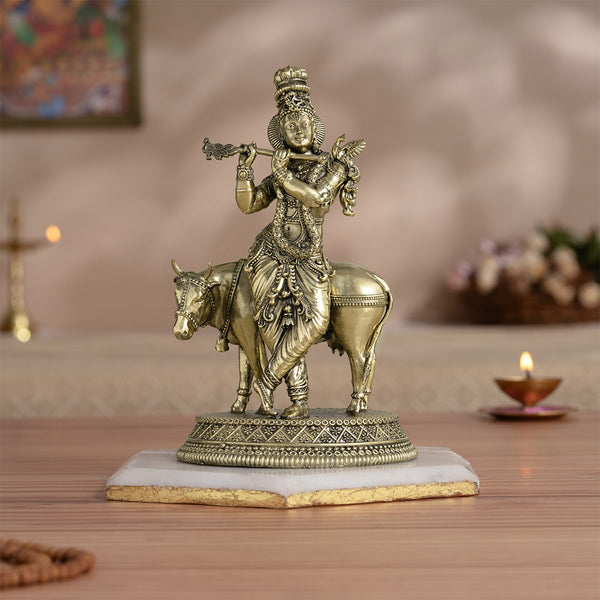
Brass Standing Krishna Statue with Cow (7 Inch)
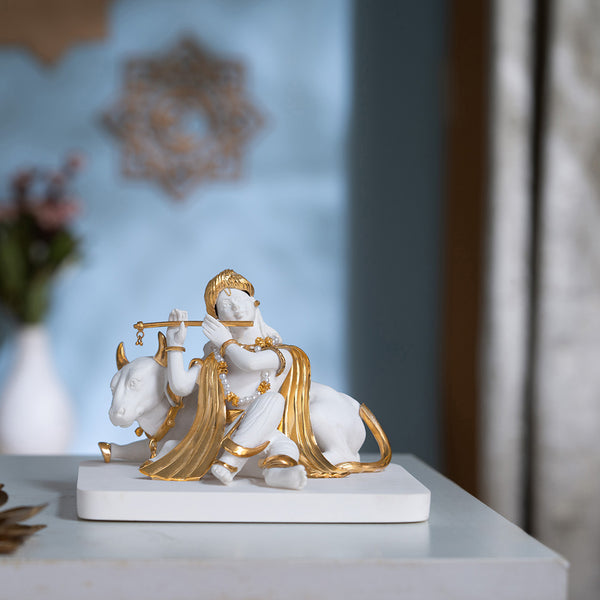
Luxurious White & Gold Lord Krishna With Cow Idol (5.5 Inch)
10. Kalki (Eternity/White Horse) Avatar

According to Hinduism, the god Vishnu will take the form of Kalki, which literally translates to "destroyer of evil," as his tenth incarnation at the end of the Kali Yuga.
According to the Purana scriptures, when the time comes for Kalki to return, he will do so mounted atop a white horse and brandishing a flaming sword.
As per Hindu eschatology, he will be the one to announce the end of time, and then he will usher in the Satya Yuga that follows.
Why did Lord Vishnu Incarnate on Earth?
1. To Protect Dharma in Troubled Times
Lord Brahma (the creator), Lord Vishnu (the preserver), and Lord Shiva (the destroyer) are the three primary deities of Hinduism (the destroyer).
Since it is Lord Vishnu's duty to keep the cosmos safe, he takes physical form whenever there is a crisis where good must triumph over evil and dharma (righteousness) must be reinstated.
2. Because of Sage Bhrigu's Curse
As the gods came to destroy the Asuras, they fled to the hermitage of Sage Bhrigu. Kavyamata, the sage's wife, fortified the hermitage with a formidable barrier.
Lord Vishnu utilized his Sudarshan Chakra to shatter the protection. He was ultimately successful in destroying it, but Kavyamata lost his life in the process.
Because of his fault of woman-slaying, Sage Bhrigu was furious with Lord Vishnu and condemned him to take many avatars on Earth, where he would endure the most suffering and captivity.
3. To Eliminate the Cruel Asuras
The majority of Lord Vishnu's incarnations, known as avatars, have some connection to the evil Asura race.
Not only does Lord Vishnu protect humans, but he also assists the gods in regaining control of heaven from the Asuras.
One of his responsibilities is to eliminate malevolent Asuras.
4. To Protect Earth
According to Hindu belief, Earth is a goddess who represents the goddess Lakshmi in human form. If the Earth's very survival is in jeopardy, he takes human form and fights for her.
The Vishnu Purana states that this has already occurred nine times and will occur again in this Yuga, the Kali Yuga (the dark age).
Vishnu: A Spiritual Conclusion
Owing to his role as the Guardian, Lord Vishnu is widely believed to take on different avatars at different points in the existence of the world to battle evil.
Despite the multiple theories in existence to this, Lord Vishnu is popularly considered to have taken nine avatars, with his tenth avatar being the final.
Frequently Asked Questions
1. What is an Avatar?
In Sanskrit, the word avatar, which also translates to "incarnation," refers to the "appearance" or "manifestation" of God or a deity as an earthly embodiment. The concept of an avatar is primarily what people think of when they hear the name, Lord Vishnu. The portrayal of the deity that is used in religious ceremonies is sometimes referred to as an idol.
2. What is the Pattern of Dashavatara?
During Satya Yuga, there were four avatars, three avatars during Treta Yuga, two avatars during Dvapara Yuga, and one avatar during Kali Yuga. The number of incarnations has gone down by one with each Yuga. Also, the first four incarnations are connected to animals, but the latter ones are all human. In the Puranas, the cow is compared to dharma, and it is thought that dharma's cow stands on four legs in Satya Yuga, three legs in Treta Yuga, two legs in Dvapara Yuga, and one leg in Kali Yuga. So it looks like the legs of the cow represent Lord Vishnu's different forms.
3. Is Vishnu Avatar 10 or 24?
While some legends state that Lord Vishnu has 24 avatars, it is more commonly believed to have 10 avatars.






